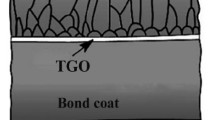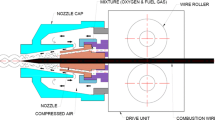Abstract
At present, coatings are mostly produced by CVD, PVD methods, plasma, and detonation spraying. Molten salts for coatings deposition are also becoming highly attractive. They provide wide possibilities for coating production of hafnium by electrodeposition, electrochemical synthesis, and precise surface alloying. Consideration is given to all these methods. The production of heat-resistant coatings from hafnium and niobium-hafnium alloys, and the electrochemical syntheses of copperhafnium solder and HfB2 coatings are also discussed.
Similar content being viewed by others
References
Andreev, Y. Y. (1979). Kinetics of alloy formation on the solid cathode during electrodeposition of metal from molten salt electrolyte. Russian Journal of Electrochemistry, 15, 49–54. (in Russian)
Baraboshkin, A. N. (1976). Electrocrystallization of metals from molten salts. Moscow, Russia: Nauka. (in Russian)
Bukatova, G. A., Kuznetsov, S. A., & Gaune-Escard, M. (2003). The electrochemical synthesis of europium boride. Journal of Mining and Metallurgy, 39B, 251–259.
Fuller, J. (2002). New directions for the air force ceramics basic research program. In The 1st ECHEM Workshop on Electrosynthesis of High Temperature Materials from Non-Aqueous Media & Related Topics, September 9–10, 2002 (pp. 5–32). Wiener Neustadt, Austria.
Glagolevskaya, A. L., Kuznetsova, S. V., & Kuznetsov, S. A. (1989). Corrosion of hafnium in chloride and mixed chloridefluoride melts. Russian Journal of Applied Chemistry, 62, 2478–2481.
Kaptay, G., & Kuznetsov, S. A. (1999). Electrochemical synthesis of refractory borides from molten salts. Plasmas & Ions, 2, 45–56. DOI: 10.1016/s1288-3255(00)87686-8.
Kuznetsov, S. A. (1993). Electroreduction of refractory-metal complexes in salt melts: specific features and relationships. Russian Journal of Electrochemistry, 29, 1323–1329.
Kuznetsov, S. A. (1996a). The effect of the second coordination sphere on electroreduction of hafnium and rhenium complexes in salt melts. Russian Journal of Electrochemistry, 32, 1310–1316.
Kuznetsov, S. A. (1996b). Electroreduction of boron in chloridefluoride melts. Russian Journal of Electrochemistry, 32, 763–769.
Kuznetsov, S. A. (2002). Electrochemical techniques. Some aspects of electrochemical behaviour of refractory metal complexes. In M. Gaune-Escard (Ed.), Molten salts: From fundamental to applications (NATO Science Series: II. Mathematics, Physics and Chemistry, Vol. 52, Chapter 66, pp. 283–303). Dordrecht, The Netherlands: Kluwer.
Kuznetsov, S. A. (2003). Surface coating for functional materials creation in ionic melts. In Proceedings of the International Symposium on Ionic Liquids in Honour of Marcelle Gaune-Escard, 26–28 June, 2003 (pp. 199–209). Carry le Rouet, France: The Norwegian University of Science and Technology.
Kuznetsov, S. A. (2009). Electrochemistry of refractory metals in molten salts: Application for the creation of new and functional materials. Pure and Applied Chemistry, 81, 1423–1439. DOI: 10.1351/pac-con-08-08-09.
Kuznetsov, S. A., & Gaune-Escard, M. (2002). Influence of second coordination sphere on the kinetics of electrode reactions in molten salts. Zeitschrift für Naturforschung A, 57a, 85–88.
Kuznetsov, S. A., & Gaune-Escard, M. (2006). Kinetics of electrode processes and thermodynamic properties of europium chlorides dissolved in alkali chloride melts. Journal of Electroanalytical Chemistry, 595, 11–22. DOI: 10.1016/j. jelechem.2006.02.036.
Kuznetsov, S. A., Kazakova, O. S., & Makarova, O. V. (2009). Electrochemical behaviour and electrorefining of cobalt in NaCl-KCl-K2TiF6 melt. Zeitschrift für Naturforschung A, 64a, 485–491.
Kuznetsov, S. A., & Kuznetsova, S. V. (2007). Electrochemical synthesis of niobium-hafnium coatings in molten salts. Zeitschrift für Naturforschung A, 62a, 425–430.
Kuznetsov, S. A., Kuznetsova, S. V., Polyakov, E. G., & Stangrit, P. T. (1990a). Alloy formation studies during hafnium electrodeposition on a copper cathode in molten salts. Russian Journal Electrochemistry, 26, 815–818.
Kuznetsov, S. A., Kuznetsova, S. V., & Stangrit, P. T. (1990b). Cathodic reduction of HfCl4 in an equimolar NaCl-KCl melt. Russian Journal of Electrochemistry, 26, 55–60.
Kuznetsova, S. V., Glagolevskaya A. L., & Kuznetsov, S. A. (1989). Effect of electrolysis parameters and the anionic composition of the electrolyte on the roughness of the hafnium coatings. Russian Journal of Applied Chemistry, 62, 488–490.
Kuznetsova, S. V., Glagolevskaya, A. L., & Kuznetsov, S. A. (1990a). Alloy formation in electrodeposition of hafnium from a melt on steel and graphite supports. Russian Journal of Applied Chemistry, 63, 2374–2377.
Kuznetsova, S. V., Glagolevskaya, A. L., & Kuznetsov, S. A. (1992). Electrodeposition of hafnium coatings from molten NaCl-KCl-HfCl4 mixture using direct and reverse currents. Rasplavy, 6, 77–82. (in Russian)
Kuznetsova, S. V., Kuznetsov, S. A., & Stangrit, P. T. (1990b). Kinetic parameters of hafnium dichloride electroreduction in NaCl-KCl melt. Russian Journal of Electrochemistry, 26, 98–101.
Nekhamkin, L. G. (1979). Metallurgy of zirconium and hafnium. Moscow, Russia: Metallurgiya. (in Russian)
Ruda, G. I., Samgina, O. Y., & Smirnov, V. P. (1983). Phase composition and thermal resistance of Hf-Nb alloys. Zashchita Metallov, 19, 984–987. (in Russian)
Sayir, A. (2002). Ultrahigh temperature composite. In The 1st ECHEM Workshop on Electrosynthesis of High Temperature Materials from Non-Aqueous Media & Related Topics, September 9–10, 2002 (pp. 42–59). Wiener Neustadt, Austria.
Shatinskiy, V. D., & Nesterenko, F. I. (1988). Protecting diffusional coatings. Kiev, Ukraine: Naukova dumka. (in Russian)
Shunk, F. A. (1969). Constitution of binary alloys (2nd supplement). New York, NY, USA: McGraw-Hill.
Tylkina, M. A., & Tsygonova, I. A. (1964). System hafniumniobium. Zhurnal Neorganicheskoi Khimii, 9, 1650–1652. (in Russian)
Author information
Authors and Affiliations
Corresponding author
Rights and permissions
About this article
Cite this article
Kuznetsov, S.A. Electrodeposition of hafnium and hafnium-based coatings in molten salts. Chem. Pap. 66, 511–518 (2012). https://doi.org/10.2478/s11696-012-0132-8
Received:
Revised:
Accepted:
Published:
Issue Date:
DOI: https://doi.org/10.2478/s11696-012-0132-8




